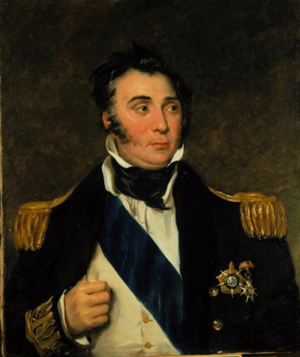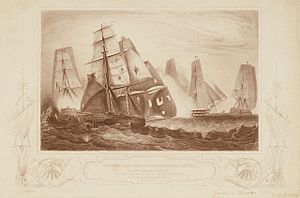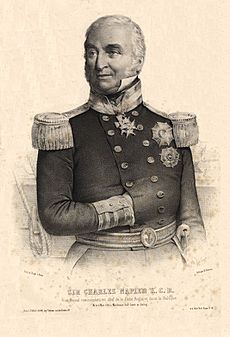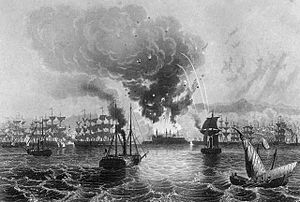Charles Napier (Royal Navy officer) facts for kids
Quick facts for kids
Sir
Charles Napier
KCB GOTE
|
|
|---|---|

Portrait of Admiral Sir Charles Napier, c. 1834
by John Simpson, Museu Nacional Soares dos Reis |
|
| Born | 6 March 1786 Falkirk, Scotland |
| Died | 6 November 1860 (aged 74) Hampshire, England |
| Allegiance | |
| Service/ |
|
| Years of service | 1799–1853 |
| Rank | Admiral |
| Battles/wars | Napoleonic Wars War of 1812 Miguelite War Egyptian-Ottoman War Crimean War |
| Awards |
|
| Alma mater | University of Edinburgh |
Sir Charles John Napier (1786–1860) was a brave and famous British naval officer. He spent 60 years serving in the Royal Navy. During his long career, he fought in many important wars. These included the Napoleonic Wars, the War of 1812, and the Crimean War. He even commanded the Portuguese navy for a time.
Napier was a forward-thinking leader. He believed in new ideas for ships, like using iron and steam power. He also cared deeply about the sailors. He wanted better living conditions and fair pay for them. He was a Member of Parliament and was well-known to the public during the Victorian Era.
Contents

Charles Napier joined the navy in 1799 as a midshipman. This was a junior officer in training. He served on several ships, learning how to command. In 1805, he became a lieutenant, a higher officer rank.
He fought in the West Indies in 1806. His ship helped capture two French warships. In 1807, he was promoted to commander. He took charge of a small warship called Pultusk.
In 1808, he commanded HMS Recruit. During a battle, a cannonball hit his leg. He was badly wounded but kept fighting. In 1809, he helped capture the island of Martinique. His clever sailing helped the British capture a large French ship. Because of this, he was promoted to post captain. This meant he could command larger ships.
After this, he was put on "half-pay." This meant he got half his usual salary because he wasn't actively serving. He used this time to study at the University of Edinburgh. He also visited his cousins in Portugal. He even fought in the Battle of Buçaco on land, saving one cousin's life.
In 1811, he returned to active duty. He commanded the frigate HMS Thames. He helped disrupt enemy shipping in the Mediterranean Sea. He also captured the island of Ponza in 1813. Later, he commanded Euryalus.
War of 1812 and the Hundred Days
After Napoleon's first defeat, Napier's ship went to North America. The War of 1812 was still happening there. He took part in an expedition up the Potomac River. His squadron captured the town of Alexandria. Napier was wounded in the neck during this mission.
He also fought in the attack on Baltimore in September 1814. His ship, Euryalus, helped bombard Fort McHenry. He led a daring night attack by small boats. However, the American defenses were too strong. The British forces had to retreat. This battle inspired Francis Scott Key to write "The Star-Spangled Banner."
After the war, Napier challenged an American ship to a duel. But before the fight could happen, news of peace arrived. When Napoleon escaped from Elba, Napier's ship returned to Britain. His last mission was to land troops in Belgium.
Family Life and New Ideas
After the wars, Napier was honored as a Companion of the Bath. He married Frances Elizabeth Elers, who was a widow. He adopted her four children. They also had two children of their own.
Napier spent some years in Italy and Switzerland. During this time, he started writing to the Admiralty. He pushed for big changes in the navy. He wanted better ship designs and new tactics. He believed in using steam power and iron for ships. He also argued for better pay and pensions for sailors. He wanted to end the "press gang" (forcing men into the navy) and flogging (whipping). He was very ahead of his time with these ideas.
He even invested his own money in steamships. In 1821, he helped build one of the first iron-hulled ships. This ship, the Aaron Manby, was the first iron ship to sail on the open sea. It also made the first direct journey from London to Paris by steamship. Despite his success, Napier went bankrupt in 1827.
Service in Portugal
In 1829, Napier commanded Galatea. He added paddles to his ship to test new ideas. This showed that ships could move without wind. But the Admiralty didn't adopt his idea.
In 1832, Portugal was in a civil war called the Liberal Wars. Napier was asked to command the Liberal fleet. He accepted and sailed to Portugal in 1833. He helped transport the Liberal army to open a new front.
On his return, he destroyed the larger Miguelite fleet. This was at the Battle of Cape St Vincent on 5 July 1833. This victory helped the Liberals capture Lisbon. For his service, he was made an Admiral in the Portuguese Navy. He was also given the title of Count of the Cape of Saint Vincent.
In 1834, he led land forces to win back the Minho region. After the war, he tried to reform the Portuguese navy. But he faced many challenges and returned to England.
Syrian War Campaign
In 1836, Napier was restored to his rank of captain in the British Navy. In 1838, he commanded the large ship-of-the-line HMS Powerful. He was sent to the Mediterranean when trouble started in Syria. Muhammad Ali, the ruler of Egypt, had invaded Syria.
In 1840, Napier, now a commodore, was sent to protect British interests. He led a landing force of Turkish soldiers and marines. He also led a combined land and sea attack on Sidon. The Egyptian army's base there surrendered.
Napier then disobeyed orders to lead a key land battle. He attacked Ibrahim Pasha's army at the Battle of Boharsef. This was a tough fight, but Napier won. It was one of the few land battles won by a naval officer.
Later, the fleet attacked Acre. The ships' cannons fired with great accuracy. A shell hit the main gunpowder storage, causing a huge explosion. Acre was captured that night.
Napier then went to Alexandria. He negotiated a peace treaty with Muhammad Ali. This treaty was important for the region's future. Napier was honored for his services. He was made a Knight Commander of the Bath (KCB). He also received awards from Russia, Austria, and Prussia.
Parliament and Channel Fleet Command
After the Syrian War, Napier became a Liberal Party MP for Marylebone in 1841. He often spoke about naval issues. He pushed for better conditions for sailors and a stronger navy. He even supported voting rights for working men.
In 1845, he was given the Freedom of the City of Edinburgh. In 1846, he was promoted to rear-admiral. In 1847, he took command of the Channel Fleet. This was a very important naval force. He was one of the most famous naval figures of his time.
His command involved protecting British interests. He dealt with issues in Portugal and Ireland. He also trained the fleet with new screw-propelled ships. In 1848, he took the fleet to Morocco. He forced the Sultan to pay for damages to British trade.
Napier returned to Britain in 1849. He was disappointed that his command ended early. He argued with the Admiralty about their decisions. He continued to speak out in newspapers and to the Prime Minister.
Baltic Campaign in the Crimean War

In 1854, the Crimean War began. Napier was given command of the Baltic Fleet. This was the largest fleet the Royal Navy had gathered since the Napoleonic Wars. His mission was to fight the Russians in the Baltic Sea.
His fleet was powerful but faced challenges. It was short on experienced sailors. Napier also received confusing orders from the Admiralty. Still, he successfully blocked all Russian ports. He kept the Russian fleet from leaving its bases.
The biggest success was capturing the Russian fortress of Bomarsund. This was a great victory for the combined French and British forces. However, Napier refused to attack the very strong fortresses of Sveaborg and Kronstadt. He believed they were too strong without special ships. This decision caused some public criticism.
Napier felt that the Admiralty was constantly questioning him. He was known for speaking his mind. This caused problems with his superiors. Despite the criticism, Napier achieved a lot. He kept the Russian Navy bottled up. He also trained his fleet, making them stronger for future battles.
Later Life and Legacy
When Napier returned from the Baltic in 1854, his command ended. The Admiralty tried to blame him for the war's perceived failures. But many sailors defended his actions.
In 1855, Napier was elected MP for Southwark. He continued to argue for better treatment of sailors in the House of Commons. He never received another command. He died on 6 November 1860. The Portuguese Navy mourned him for eight days.
Character
Sir Charles Napier was known for his energy and courage. But he was also a bit unusual and proud. He often argued with the Admiralty. Sailors nicknamed him 'Black Charlie' because of his dark looks. He was also called 'Mad Charlie' for his unique ideas. And 'Dirty Charlie' because he wore old clothes, even though he insisted his officers dress perfectly.
Memorial
There is a memorial to Sir Charles Napier inside St Paul's Cathedral in London.
Popular Culture
Around 1845, the composer Stephen Glover wrote a piece of music called "The Retreat from St. Jean d'Acre." He dedicated it to Commodore Napier.




